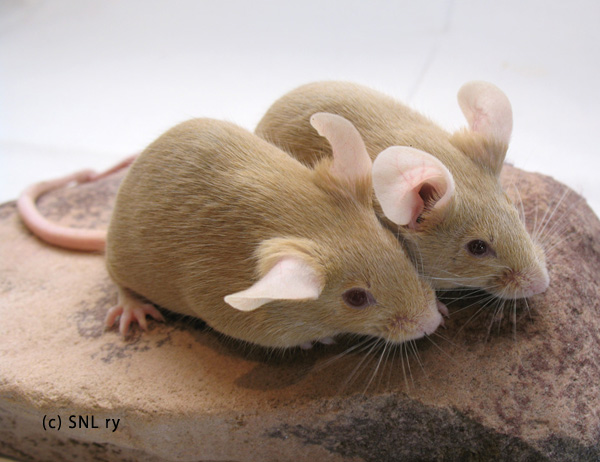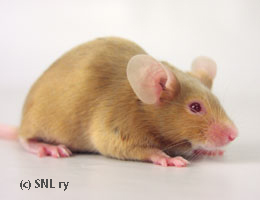Varieties
Ticked
Argente (ar)
A/A B/* C/* D/* p/p, or
A/a B/* C/* D/* p/p
"Eyes pink. An argente mouse shall be of a delicately blended shade of light fawn and silver, as the self silver, level throughout and the two colors so evenly intermingled as to give the appearance of shot silk. The undercolour to be blue, as dark as possible in shade. The belly to be a golden fawn and as similar to the top as possible. Feet to match top."
Breeding information below the pictures.
Original text: Anniina Tuura.
Basics
Agente is one of the oldest colour varieties in mice. In order to ”build” on, you will only need to add the ancient red eye mutation to wild type agouti. The name of this variety is a bit misleading, as ”Argente” is French for silver.
This variety tends to disappear from shows for ages and then reappear for a while. Luckily this is also one of the easiest varieties to recreate.
Standard for Argente says: "Eyes pink. An argente mouse shall be of a delicately blended shade of light fawn and silver, as the self silver, level throughout and the two colors so evenly intermingled as to give the appearance of shot silk. The undercolour to be blue, as dark as possible in shade. The belly to be a golden fawn and as similar to the top as possible. Feet to match top."
It is hard to imagine what a good Argente looks like from the standard alone. One really needs to see not only good ones, but also bad ones from both ends of the scale of ”bad Argente”. Argente is notorious for being one of those varieties where judges seem quite unable to agree what a great one looks like. However, this may be partly due to it being a come-and-go variety: judges may not have seen a single good Argente while in training.
Argentes can vary greatly in appearanve. They can be anything between light creamish yellow with silvery back and creamy belly with a hint of argente on the sides, to ”cinnamon with red eyes”. The desired version is closer to the lighter end of this scale.
Breeding in Practice
The standard compares this variety to ”light fawn”. In this case, light really does mean light. Too strong a shade of fawn loses the next required reature: silvering. Argente should be evenly ticked with light silver, like Agouti is ticked with black. The overall appearance should be beautifully warm, not cold. The ”shot silk” mentioned in the standard is the result of a perfect blend of light but warm shade combined with an even silvering.
The undercolour should be clearly grey. It isn’t truly blue as such (with the exception of very dark individuals), but more like Dove. There are some necessary compromises to be made with the undercolour, as the darker the undercolour is, the darker the overcolour will be. If the undercolour is closer to Silver in shade, it is too light. The undercolour should not ”shine through” (that is: be seen withouth blowing the coat open) the overcolour, as it is a common fault in Argente.
”Golden fawn” doesn’t describe Argente’s belly colour too well. It is unclear what is meant by the term, as one can easily (and falsely) picture and average shade of Fawn and that is not what the belly of an Argente is – nor can be – if the back is of the required ”light fawn” in shade. The idea seems to be that the belly should match the top as closely as possilbe and not be lighter.
In addition to those mentioned above, common faults in Argente include light points and uneven ticking. Molting causes patches and stripes in the ticking and main colouring. Having umbrous causes ticking to be heavy on mouse’s top side, which shows as a silvery back on an Argente.
Wrong genotypes case faulty colouring on an Argente. These genotypes do not have names of their own and are referred to simply as ”Argente UT (ut = untypical”). b/b turns undercolour from dove to champagne, d/d makes the shade cold and undercolour closer to silver. Argente Tan isn’t a fault as such but isn’t a variety to strive for. Tan belly is quite close in colour to the top and mostly looks like a bad Argente with a faint demarcation line visible.
If there are no snow quality Argentes available, it is better to start building with too light than too dark individuals. It is easier to strengthen the shade with Dove and Fawn, than it is to breed Argentes lighter. You can also use mice with correct shade, but incorrect undercolour to get the variety started. Light (but not sooty!) Fawn and light Dove are suitable for breeding Argentes even well into the variety, although it is adviceable to prefer Argente x Argente crossings.
Argente isn’t too suitable for breeding in tandem with another variety, possibly excluding Pale Argente (A/A \ A/a cch/cch p/p). All other varieties call for qualities opposing or unsuitable for and Argente, so their respective modifiers tend to be ill fitting for each others. It is better to avoid other varieties of the agouti group (exl. pale argente), dilutes (b/b, d/d) and tan.
It is not easy to tell a good Argente looks like as a pup, although it gets easier with practice. Too dark youngsters will never grow up to be adults of correct shade, too light ones might turn up quite pretty. Like with Agouti and Cinnamon, Argentes mature in shade with age. Some Argente young may look perfect but develop fawn-y top colour (too dark), others may resemble silvers in their first coat, but grow to be proper Argentes later on – though probably with too much silvering. It pays to keep the most promising Argente pups until they have grown their adult coats. Young Argentes always look paler than adults, but if the colour simply does not get better with the adult coat, that's it for shows.



